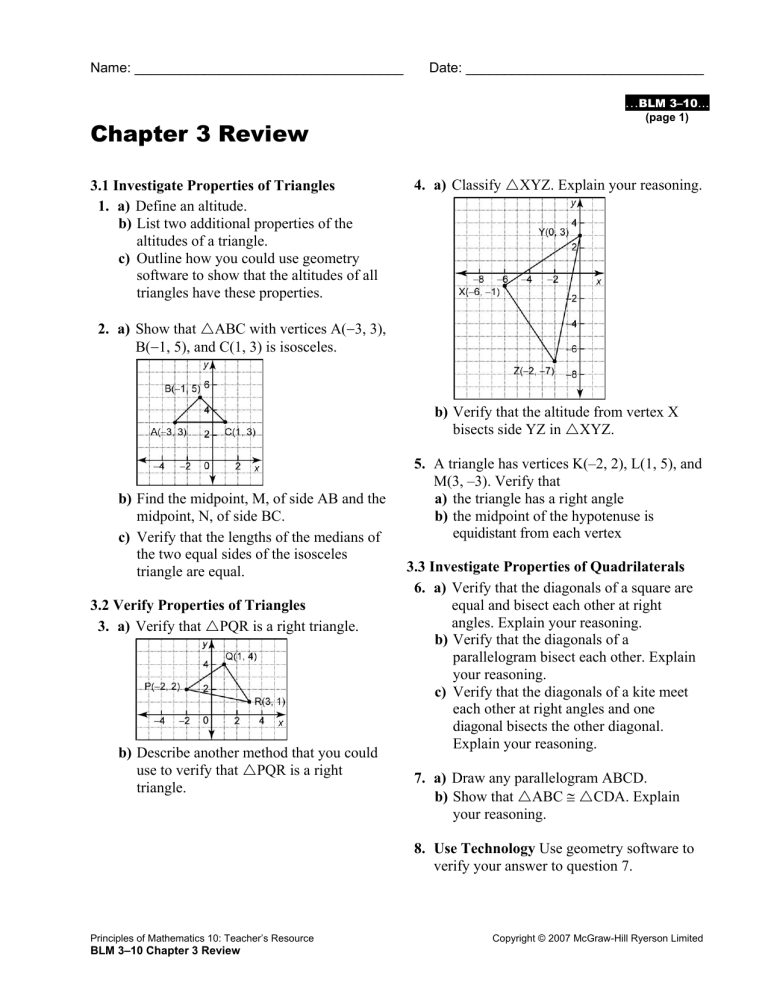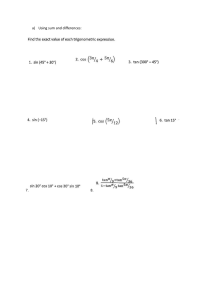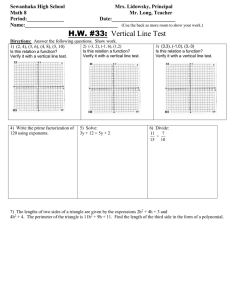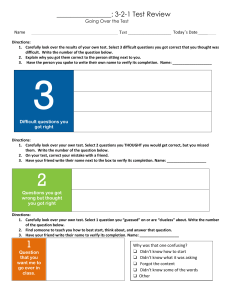
Name: ___________________________________ Date: _______________________________ …BLM 3–10... Chapter 3 Review 3.1 Investigate Properties of Triangles 1. a) Define an altitude. b) List two additional properties of the altitudes of a triangle. c) Outline how you could use geometry software to show that the altitudes of all triangles have these properties. (page 1) 4. a) Classify XYZ. Explain your reasoning. 2. a) Show that ABC with vertices A(3, 3), B(1, 5), and C(1, 3) is isosceles. b) Verify that the altitude from vertex X bisects side YZ in XYZ. b) Find the midpoint, M, of side AB and the midpoint, N, of side BC. c) Verify that the lengths of the medians of the two equal sides of the isosceles triangle are equal. 3.2 Verify Properties of Triangles 3. a) Verify that PQR is a right triangle. b) Describe another method that you could use to verify that PQR is a right triangle. 5. A triangle has vertices K(–2, 2), L(1, 5), and M(3, –3). Verify that a) the triangle has a right angle b) the midpoint of the hypotenuse is equidistant from each vertex 3.3 Investigate Properties of Quadrilaterals 6. a) Verify that the diagonals of a square are equal and bisect each other at right angles. Explain your reasoning. b) Verify that the diagonals of a parallelogram bisect each other. Explain your reasoning. c) Verify that the diagonals of a kite meet each other at right angles and one diagonal bisects the other diagonal. Explain your reasoning. 7. a) Draw any parallelogram ABCD. b) Show that ABC CDA. Explain your reasoning. 8. Use Technology Use geometry software to verify your answer to question 7. Principles of Mathematics 10: Teacher’s Resource BLM 3–10 Chapter 3 Review Copyright © 2007 McGraw-Hill Ryerson Limited Name: ___________________________________ Date: _______________________________ …BLM 3–10... (page 2) 3.4 Verify Properties of Quadrilaterals 9. Verify that quadrilateral DEFG is a parallelogram. 10. Verify that the quadrilateral with vertices P(2, 3), Q(5, –1), R(10, –1), and S(7, 3) is a rhombus. 11. a) Draw the quadrilateral with vertices P(3, 4), Q(2, 6), R(0, 5), and S(1, 3). b) Classify quadrilateral PQRS. Justify this classification. c) Verify a property of the diagonals of quadrilateral PQRS. 12. A quadrilateral has vertices K(–1, 4), L(2, 2), M(0, –1), and N(–3, 1). Verify that a) KLMN is a square b) each diagonal of KLMN is the perpendicular bisector of the other diagonal c) the diagonals of KLMN are equal in length Principles of Mathematics 10: Teacher’s Resource BLM 3–10 Chapter 3 Review 3.5 Properties of Circles 13. a) Show that X( 4, 3) and Y(4, 3) are endpoints of a diameter of the circle x2 + y2 = 25. b) State the coordinates of another point Z, with integer coordinates, on the circle x2 + y2 = 25. c) Show that XYZ is a right triangle. 14. a) Verify that the points D(2, 5) and E(5, 2) lie on the circle with equation x2 + y2 = 29. b) Verify that the right bisector of the chord DE passes through the centre of the circle. 15. Find the centre of the circle that passes through the points P(–9, 5), Q(1, 5), and R(–2, –2). Copyright © 2007 McGraw-Hill Ryerson Limited



